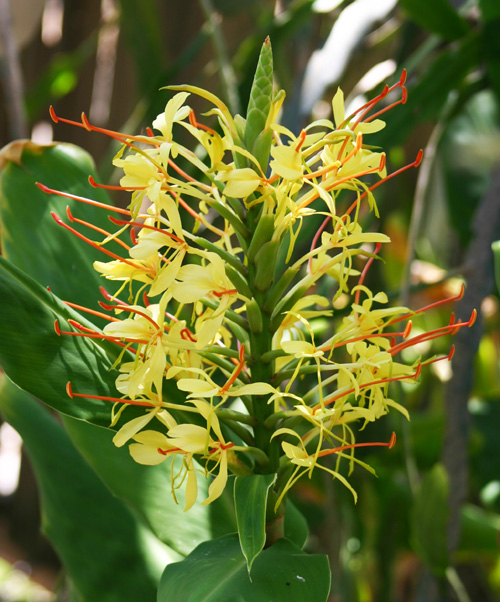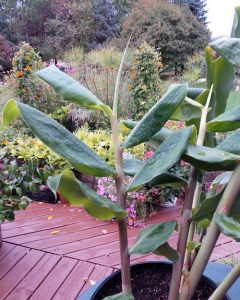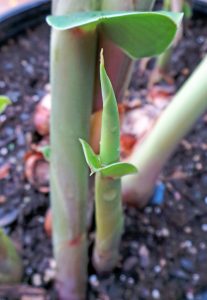
With fragrant towers of flowers and bold foliage, kahili ginger, Hedychium gardnerianum, is a dramatic tropical plant. Native to moist tropical forests of the eastern Himalayas in northern India, Nepal and Bhutan, this plant in the ginger family (Zingiberaceae) is the most widely cultivated of all species of the genus Hedychium (pronounced “heh-DIK-ee-um”), and is a popular landscape ornamental throughout the world in tropical and subtropical area. It has naturalized in other areas, including the Caribbean and Hawaii, and is considered an invasive species in some parts of the world. As a tropical or subtropical plant (zones 8-11; the roots will survive light, infrequent frost, but the leaves will not), kahili ginger must be grown as a seasonal or indoor plant in the upper Midwest. It cannot survive our harsh winters, so must be grown as a container plant. This plant has many common names, including ginger lily, yellow ginger lily, kahili garland lily, kahili ginger, and kahili ginger lily.

Kahili ginger is a large herbaceous plant with rapid vegetative growth. The annual, upright pseudostems arise from thick, perennial rhizomes. In the ground it can grow to 8 feet tall but is generally much shorter in container culture. The widely-spaced, alternate leaves clasp the thick stems in two parallel ranks. The lance-shaped leaves are up to 2 feet long but relatively narrow (4-6 inches wide) with entire margins and pointed tips. They are glossy green on the upper surface and powdery-white below. The plant reproduces vegetatively by rhizomes and in mild climates can colonize large areas this way. The stems eventually senesce and die, with a new stem growing from an axillary bud present in the rhizome.

The showy flower spikes appear in late summer or early fall. Up to 50 flowers are borne in erect, dense, 1½-2 foot tall cylindrical racemes at the tips of the stems. The bright yellow flowers, each with a single, prominent stamen, emerge from cylindrical cones of green bracts. Narrow green bracts subtend each group of one or two flowers. Each flower has three large “petals” (inner tepals) that are fused together at the base into a narrow tube and a fourth, two-lobed, spoon-shaped tepal (a labellum) that is centrally tinged orange. The inconspicuous outer tepals are fused into a tube. There are also two elongated greenish-yellow lateral staminodes and a single large stamen borne on a long bright orange/red filament that is much longer than the labellum. The flowers have a strong, sweetly scented fragrance.

In mild climates flowers may be followed by fruit, thin-walled orange capsules that split open when mature. The persistent, three-chambered capsules have a bright orange inner surface and small, sticky, shiny bright red seeds that are spread by birds and mammals.

In the Midwest, kahili ginger is used as a seasonal or greenhouse plant. The foliage of kahili ginger is dramatic and architectural, so it looks great even not in bloom in summer on patios or decks with a tropical theme. Combine it with dark-leaved elephant ears, tall papyrus, and colorful annuals to bring an exotic look to a landscape. Because it blooms fairly late in the season, it may need to be moved indoors to enjoy the fragrant flowers if frost threatens.

This ginger needs rich soil and plentiful water throughout the year to achieve the most luxuriant growth. In the Midwest it does best in full sun but tolerates partial shade. Water and fertilize regularly during the growing season, but cut back in winter. It tolerates short periods of drought but not standing in water. To keep it actively growing year round requires a fair amount of space and bright indirect light indoors in the winter. Plants overwintered indoors should remain inside until temperatures are consistently in the 40ºFs at night, and should be acclimated gradually to the brighter light outdoors before moving to their desired spot for the remainder of the growing season. The plants can be put in the ground (grow them like a canna) or remain in containers to make the move indoors before the first frost in fall easier. If the leaves are allowed to be killed by frost, cut back the stems to a few inches above the ground and hold in a dormant state (either in soil in the pot, or bare, stored as for dahlias or cannas) in a cool, frost-free place over the winter. Repot (dividing if necessary) in early spring and keep in a warm location (room temperature) to get the plants growing again well before they are to be moved outside after the last frost. These are vigorous plants with large, heavy rhizomes that can easily break containers if they don’t have sufficient room for the roots, so use large, sturdy containers.
This species is propagated by division in spring or from seed. The rhizomes are easily divided with a sharp knife, making sure there is one or more growing tip on each section. Allow the cut rhizomes to dry for a day or two before planting. Water sparingly until new shoots emerge from the soil. Growing from seed requires several years to get blooming plants. Seeds should be planted as soon as they are ripe and soaked for a few hours in warm water before planting. They should germinate in 3-4 weeks.
A few cultivars may be available, such as ‘Extendum’. Other similar species that are common in cultivation include white ginger (H. coronarium, with short clusters of white flowers with white stamens), yellow ginger (H. flavescens, with short clusters of pale yellow flowers with yellow stamens) and red ginger (H. coccineum, with elongated clusters of red, salmon or pink flowers), as well as hybrids between these species.

– Susan Mahr, University of Wisconsin – Madison
Latest Horticulture News
Ask Your Gardening Question
If you’re unable to find the information you need, please submit your gardening question here:





 Marigolds
Marigolds Create a Butterfly Garden
Create a Butterfly Garden Plant Flowers to Encourage Beneficial Insects
Plant Flowers to Encourage Beneficial Insects Forcing Bulbs
Forcing Bulbs


